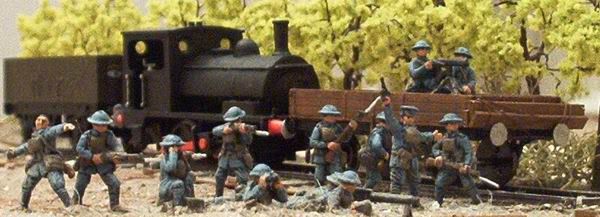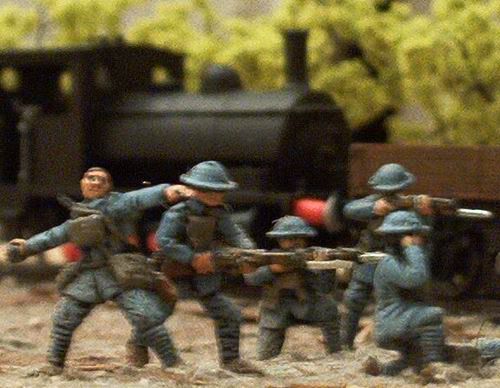Portuguese Expeditionary Corps
Dated: June 22, 2008.
By
Mr. Nuno M. Cabešadas
Portugal
Portugal become a Republic in October 1910, after more than seven centuries as an independent kingdom and the whole country was in a turmoil when the Great War began.
The Portuguese involvment had two main purposes, one being to defend the African colonies from the attack of the Germans and the other to achieve credibility to the new regime, still suffering from constant changes of government and facing an economic crisis.
The Portuguese Expeditionary Corps was composed of two divisions and an independent artillery brigade, later an independent heavy artillery corps, reaching near 50.000 men sent to France in 1917. These men were near half of the Portuguese Army, with the other half fighting since 1914 in Africa and garrisons sent to several islands to avoid any German invasion atempt.
Portuguese colonies in Africa become under attack from German forces and forces were sent from Europe to join local units, colonists, militia and Askaris. This force included almost every professional infantry and cavalry soldiers and a significant part of the field artillery, leaving in Portugal mostly heavy artillery, unsuitable to perform in Africa and garrison units.
When new units become required to fight in France, two new divisions of 40.000 conscripts were raised in Tancos in a very little time, in what was called the "miracle of Tancos". In these days, some officers wanted to partially swap the professional army fighting in Africa with the new recruits, however time, costs and logistic issues prevent this idea to go forward. Now, most people realize that it was a serious mistake to send these conscripts to France without more veterans, even if when they arrived they received training from the British before being sent to the front.
The infantry had most of the uniform and equipment changed, becoming identical to the British, except concerning the horizon blue color, and the Portuguese Mauser-Vergueiro was replaced by the British Enfield to avoid supplying different caliber ammunitions. The typical Portuguese helmet was also replaced by the cheaper and more effective British model and Lewis and Vickers machine guns, Stokes mortars and other support weapons become available. Officers retained their American Savage and the German Lugers as side arms, but some unpopular Webley revolvers were also present.
After arriving in France, the Heavy Artillery Brigade was assigned to the French, who gladly received several hundreds of guns of callibers up to 240 mm and manned by professional crews, while the two infantry divisions came under Britsh command, thus defeating the Portuguese plans to send an important artillery unit knowing that it was needed to support the infantry as they still need to complete the training and achive combat experience.
Political reasons were behind such decision, mainly the need to split the expeditionary force between the British and the French, and doomed the Portuguese infantry, being responsible for the heavy casualties suffered and for the lack of supplies, sent primarly to the better equiped and much more effective Artillery Corps.
The soldiers of Portuguese Expeditionay Corps, who many called "Portuguese Lambs for Exportation", stayed in the front for months, without leave to Portugal, because there was no money, logistics to do so, nor replacements, as there no more reserves available.
In these months, the number of casualties reduced the Portuguese force to near half when they faced the German attack from "Operation Georgette", where nearly 20.000 soldiers hopelessly faced some 100.000 enemy after a heavy artillery bombardment.
The Battle of La Lys, as is known in Portugal, become almost fatal to the Portuguese forces, when what was left from over a year in the front suffered heavy casualties, with several units being destroyed, others moving back and a few surrounded, holding small villages for one or two days until overwhelmed or captured together with the British reinforcements who shared the same fate.
The battle itself, no matter what some Portuguese historicians wrote, was a disaster with rally points around the divisional headquarters, one regiment HQ fighting to the end and having most of the staff, including the commander killed, units dispersed or routed and guns lost after close quarters combat between crews and German assault troops.
After a reorganization, the divisions become just one and was returned to the front, after what was the only real leave out of range from enemy fire and stayed there until the Armistice.
Portuguese losses in the Great War reach 20.000, with more than 7.000 dead, most of them in France where many of them are still buried in military cemeteries.
In a brief note, the effectivness of the Portuguese Corps resided in the Heavy Artillery support and the HQ had confidence hat even these conscripts could face the Germans if backed by the 25 batteries sent together with the two infantry divisons. Most Portuguese officers were aware that the large number of guns are needed to help the the infantry to hold their overstretched lines.
The firepower of these heavy guns with batteries up to 320 and 240 mm should have been able to support the infantry and raise the confidence of those who were in the front. Besides, having the Artillery and Infantry Corps together would have helped logistics and coordination and taken advantage of the training tactics learned in Portugal. Splitting the Artillery and Infantry was a political decision resulting in many losses and showed how a bad move can destroy all the work done by the military in Tancos and after the arrival in France.
Attached are a few picture of the Portuguese Expeditionary Corps in France-1917. In late 1917, Portuguese soldiers were dressed and equiped with British supplied uniforms, weapons and gear and the main differences from the allies were the horizon blue color and a few helmets still unreplaced.





Many thanks to Mr. Nuno M. Cabešadas.
(Webmaster: Pictures of WWI Portuguese uniforms can be found here: http://www.cascoscoleccion.com/portugal/por16.htm)